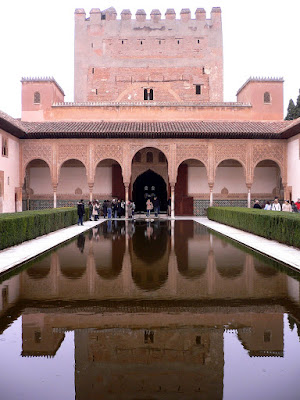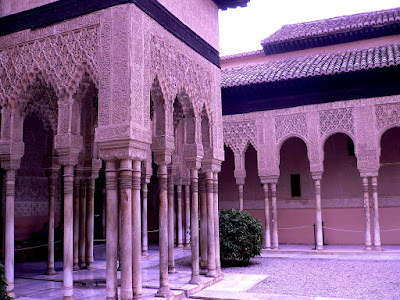Sunday, March 25, 2007
Granada, Spain, 21-22 Feb 2007: Alhambra, Palacios Nazaries
The Mexuar, Comares And Leones Palaces
   |
| The Moorish Nasrid Palaces are the Alhambra's jewels. The complex consists of three interconnecting palace groups - the Mexuar Palace, the Comares Palace and the Leones Palace - and the Lindaraja Gardens. Elegant uncluttered lines and spacious courtyards harmonize with ingenious use of water landscape to create an oasis of unrivalled beauty. Due to Islam's prohibition against the use of imagery, the walls and ceilings of the palaces are replete with intricate geometrical designs and religious calligraphic art. They permeate the buildings - integral to the whole, never overwrought - subtly transforming with every shifting light throughout the day. The artisans used plaster almost exclusively for decorative stucco work and were experts in delicate alicatado mosaic tiling. They seemed to be cognizant of the impermanence of the worldly Earth, reveling in the ethereal frailty of their creations. |
 |
| The Courtyard of the Mexuar leads from the Hall of the Mexuar to the Comares Palace. At the adjoining Golden Chamber, visitors waited to be admitted to the Nasrid Sultan's presence. On the southern side of the courtyard is an impressive facade of foliate stucco work that becomes increasingly intricate as the eye scales the wall. |
  |
| The Comares Palace is the nucleus of the Nasrid Palaces. Simplicity of line and balanced proportions lend a serene majesty to the Courtyard of the Myrtles. The Comares Tower appears to magically float on the reflecting pool. Pluck a few leaves from the myrtle shrubs and rub them between the fingers - they emit a most wonderful and refreshing scent. |
  |
| Leave the Courtyard of the Myrtles, and enter the Hall of the Boat. Observe the play of reflected light on the jambs at the entrance. Enter the Hall of the Ambassadors or Throne Room - the palaces' most sumptuously decorated room. Imagine the effect the Sultan had on his minions as he loomed half hidden in the shadowy central alcove at the far wall, silhouetted against the dappled light that filtered in through the filigree stained glass wall. |
  |
| The Leones Palace was the Sultan's private dwellings. The central Courtyard of the Lions is surrounded by myriad slender columns - perhaps reminiscent of the palm trees in a desert oasis in the Sultan's longed-after homeland. The fountain with twelve lion statues, spouting water from their mouths, has been temporarily dismantled for conservation work. |
   |
| The Hall of the Abencerrages and the Hall of the Two Sisters face each other on opposite ends of the courtyard. Both boast magnificent honeycombed plaster mocarabes ceilings. Legend has it that the former was believed to be the site of the infamous slaugther of the Abencerrages clan for one male member's alleged affair with the Sultana. The Hall of the Two Sisters, named for two large flawless slabs of Macael marble at the centre of the floor, leads into the Mirador of Lindaraja. The mirador's beautiful mullion window in the north wall overlooks the Lindaraja Garden, with trickling fountains set amidst fragrant orange trees. |
   |
Labels: architecture, art, Granada, palace, sculpture, Spain

Licensed under Creative Commons Attribution-NonCommercial-NoDerivs 2.5 License

These are the 30 countries that I have ever set foot on. Airport stopovers don't count!

